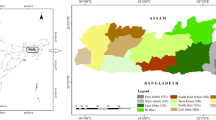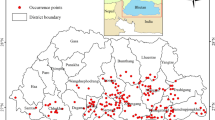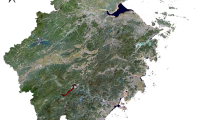Abstract
Potential habitat modeling of endemic species is an appropriate method to maintain biodiversity, ecosystem function and rehabilitation of rangeland ecosystems. Astragalus caragana, A. cyclophyllon and A. podolobus are endemic in Iran’s rangelands and some neighboring countries. The three native species could endure environmental stresses due to their distinctive ecophysiological characteristics. They play important roles in sustainable pastures production, recreation and improvement. They suffer severe threat from many factors including; grazing, agriculture and invasive exotic species. We analyzed the potential habitat of three native plant species in central Iran basing on the grid map with the resolution of 1-km. We used inventory records from field surveys, herbarium collections and 22 environmental factors to explore the environmental influences on given species distribution by Maximum entropy (Maxent) model. Maxent is a species distribution model that uses species occurrence and environmental data for predicting potential species. The results of our study indicated species occurrence has strong correlation with environmental factors such as mean temperature of wettest season, elevation and precipitation of coldest season. We evaluated the model accuracy by AUC (area under the receiver operating characteristic curve) based on an independent test data set. AUC values indicated the high power of Maxent to create potential habitat map (AUC A. caragana =0.988, AUC A. cyclophyllon =0.927, AUC A. podolobus =0.923). It is important to consider that AUC values tend to be lower for species that have broad distribution scope, such as A. podolobus distribution. Most suitable potential habitat distributions of the three species were predicted in the western and southwestern parts of rangelands in Isfahan province. Visual comparisons of the actual distribution map of the three species with produced Maxent maps represent a good agreement. In general, the model demonstrated that the occurrence of the given species is highly probable when the elevation is between 2,200 and 3,000 m and mean temperature of wettest season less than 3°C. This model, therefore, can be applied to recognize potential sites for rangeland reclamation projects.
Similar content being viewed by others
References
Adhikari D, Barik S K, Upadhaya K. 2012. Habitat distribution model ling for reintroduction of Ilex khasiana Purk., a critically endangered tree species of northeastern India. Ecological Engineering, 40: 37–43.
Anderson R P, Lew D, Peterson A T. 2003. Evaluating predictive models of species distributions: criteria for selecting optimal models. Ecological Modelling, 162: 211–232.
Andrieu N, Josein E, Duru M. 2007. Relationships between diversity of grassland vegetation, field characteristics and land use management, agriculture. Ecosystems and Environment, 120: 359–369.
Ansari-Renani H R, Rischkowsky B, Mueller J P, et al. 2013. Nomadic pastoralism in southern Iran (Research, Policy and Practice). Pastoralism, 3(11): 25.
Basiri R, Taleshi H, Poorrezaee J, et al. 2011. Flora, life form and chorotypes of plants in river forest Behbahan, Iran. Middle East Journal of Scientific Research, 9(2): 246–252.
Brotons L, Thuiller W, Araujo M B, et al. 2004. Presence-absence versus presence only modelling methods for predicting bird habitat suitability. Ecography, 27: 437–448.
Dorner J. 2002. An Introduction to Using Native Plants in Restoration Projects. Washington: U.S. Environmental Protection Agency, 5–20.
Elith J, Graham C H, Anderson R P, et al. 2006. Novel methods improve prediction of species distributions from occurrence data. Ecography, 29: 129–151.
Elith J, Philips S J, Hastie T, et al. 2011. A statistical explanation of Maxent for ecologists. Diversity and Distributions, 17: 43–57.
Evangelista P H, Kumar S, Stohlgren T J, et al. 2008. Modelling invasion for a habitat generalist and a specialist plant species. Diversity and Distributions, 14: 808–817.
Faraji M, Arzani H, Tavili A, et al. 2009. Potential of rain-fed farming in abandoned dry framings based on climatic and physical factors (case study: Taleghan basin). Iranian Journal of Rangeland, 3(1): 90–106.
Feizi M T. 2005. Final report of autecology of Astragalus podolobus Boiss. in Isfahan province. Iran: Research Institute of Forests and Rangelands, 15–73.
Hoffman J D, Narumalani S, Mishra D R, et al. 2008. Predicting potential occurrence and spread of invasive plant species along the North Platte River, Nebraska. Invasive Plant Science and Management, 1: 359–367.
Hosseini S Z, Kappas M, ZareChahouki M A, et al. 2013. Modelling potential habitats for Artemisia sieberi and Artemisia aucheri in Poshtkouh area, central Iran using the maximum entropy model and geostatistics. Ecological Informatics, 18: 61–68.
Joneidi H, Nikoo S, Gholinejad B, et al. 2012. Effect of converting rangelands to dry land farming on soil organic carbon, case study Kurdistan province. Iranian Journal of Rangeland, 6(1): 34–45.
Khodagholi M. 2006. Final report of autecology of Astragalus caragana in Isfahan province. Research Institute of Forests and Rangelands. Iran, 12–85.
Kumar S, Stohlgren T J. 2009. Maxent modeling for predicting suitable habitat for threatened and endangered tree Canacomyrica monticola in New Caledonia. Ecology and Natural Environment, 1(4): 94–98.
Maassoumi A A. 1998. Astragalus in the Old World Check-list. Iran: Research Institute of Forests and Rangelands, 347–348.
Mcpherson J M, Jetz W. 2007. Effects of species’ ecology on the accuracy of distribution models. Ecography, 30: 135–151.
Ortega-Huerta M A, Peterson A T. 2008. Modeling ecological niches and predicting geographic distributions: a test of six presence-only methods. Revista Mexicana De Biodiversidad, 79: 205–216.
Peterson A T, Soberón J, Pearson R G, et al. 2011. Ecological Niches and Geographic Distributions. Princeton: Princeton University Press, 112–125.
Philips S J, Dudik M, Schapire R E. 2004. A maximum entropy approach to species distribution modeling. In: Proceedings of the 21st International Conference on Machine Learning (ICML) 4–8 July 2004. Seattle, Washington, USA, 655–662.
Phillips S J, Anderson R P, Schapire R E. 2006. Maximum entropy modeling of species geographic distributions. Ecological Modeling, 190: 231–259.
Poulos H M, Chernoff B, Fuller P L, et al. 2012. Mapping the potential distribution of the invasive red shiner, Cyprinella lutrensis (Teleostei: Cyprinidae) across waterways of the conterminous United States. Aquatic Invasions, 7(3): 377–385.
Scheldeman X, van Zonneveld M. 2010. Training manual on spatial analysis of plant diversity and distribution. Biodiversity International, 139–158.
Schuman G E, Janzen H, Herrick J E. 2002. Soil carbon information and potential carbon sequestration by rangelands. Environmental Pollution, 116: 391–396.
Shahmoradi A A. 2006. Final report of autecology of Astragalus cyclophyllon G. Beek in Isfahan province. Iran: Research Institute of Forests and Rangelands, 8–54.
Stohlgren T J, Jarnevich C S, Esaias W E, et al. 2011. Bounding species distribution models. Current Zoology, 57(5): 642–647.
Tarkesh M, Jetschke G. 2012. Comparison of six correlative models in predictive vegetation mapping on a local scale. Environmental and Ecological Statistics, 19(3): 437–457.
Yang X Q, Kushwaha S P S, Saran S, et al. 2013. Maxent modeling for predicting the potential distribution of medicinal plant, Justicia adhatoda L. in Lesser Himalayan foothills. Ecological Engineering, 51: 83–87.
Author information
Authors and Affiliations
Corresponding author
Rights and permissions
About this article
Cite this article
Ardestani, E.G., Tarkesh, M., Bassiri, M. et al. Potential habitat modeling for reintroduction of three native plant species in central Iran. J. Arid Land 7, 381–390 (2015). https://doi.org/10.1007/s40333-014-0050-4
Received:
Revised:
Accepted:
Published:
Issue Date:
DOI: https://doi.org/10.1007/s40333-014-0050-4




